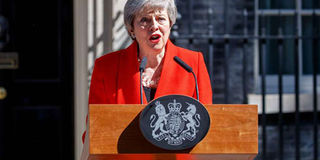May failed the Brexit test and her successor should be taking notes

Britain's Prime Minister Theresa May announces her resignation outside 10 Downing street in central London on May 24, 2019. PHOTO | TOLGA AKMEN | AFP
What you need to know:
- Mrs May did not have a majority in Parliament. When in 2017 she called a snap General Election, she hoped to capitalise on a 20-point lead in opinion polls to garner a massive majority.
- The House of Commons was divided along party lines and the two main parliamentary parties, the governing Conservatives and opposition Labour, were split between leaving and remaining in the EU.
It was veteran MP Kenneth Clarke, a former Chancellor of the Exchequer, who in 2016 described Mrs Theresa May, then an aspirant for the premiership, as “a bloody difficult woman”.
It was no compliment. In 2018, two years into her premiership, Mrs May confirmed to her Conservative Party conference that she was proud to be a bloody difficult woman.
She had turned Mr Clarke's slight into a compliment.
As Prime Minister, she swore to deal with Brussels in negotiations on Britain's exit (Brexit) from the European Union (EU) in a bloody difficult manner in search of a good deal for the UK.
A slur had become both inspiration and weapon for realisation of her mantra: “Brexit means Brexit (we must leave the EU), and we are going to make a success of it.”
PARTY POLITICS
Brexit neatly defined Mrs May's three-year premiership, totally consumed it and, quickly destroyed it. But did she fail because she is bloody difficult? No.
Mrs May was failed by the politics generated by the June 2016 referendum, in which some 30 million Brits voted, by a margin of 52 per cent to 48 per cent for quitting and remaining in the EU respectively.
One, neither the referendum nor triggering of Article 50, which governs an exit from the EU, prepared or provided the government or people or Parliament with the mechanics or tools of leaving.
This was left to Parliament to determine. The House of Commons was divided along party lines and the two main parliamentary parties, the governing Conservatives and opposition Labour, were split between leaving and remaining in the EU.
With the Conservatives split between the hard Brexiteers and the soft on one hand, and the Brexiteers and Remainers on the other, Mrs May was dealt a bad hand.
Two, worse, these divisions manifested themselves at the Cabinet table.
SNAP POLL
Three, Mrs May did not have a majority in Parliament. When in 2017 she called a snap General Election, she hoped to capitalise on a 20-point lead in opinion polls to garner a massive majority.
But, Conservatives lost their majority of 13. Mrs May was forced to enter into a confidence and supply agreement with the Northern Irish Democratic Unionist Party (DUP) to prop up her minority government. DUP did not support May's Brexit plan.
Four, governing parties do not like dealing with the opposition and the latter are not in the business of propping up the former.
But with divided parties, government and Parliament, the UK needed a cross-party coalition or consensus to progress Brexit.
Mrs May created neither at the outset and when she turned to Labour in search of a consensus, her Brexit plan had been defeated three times in Parliament with the generous help of her own party.
DEPARTURE
Five, as this was happening, the March 29 deadline for the UK to have left the EU had come and gone, Mrs May had lost more than 30 ministers.
The picture of chaos and shambles in London contrasted sharply with the unity of purpose shown by Brussels.
Twenty-seven EU-member countries were united, but Mrs May could not unite her party or her cabinet; could not form a coalition to push the UK's Brexit interest, or, put another way, could not deliver Brexit.
Lastly, because Mrs May could not deliver on her raison d'etre, a new political party, the Brexit Party, emerged to wallop the Conservatives and Labour in the EU elections after only six weeks of existence.
LESSON
Mrs May's failure was writ large. She had to go. But she is not going away with the conundrum that is Brexit.
The politics and, more importantly, the arithmetic, are still the same and, await her successor.
Any country, Kenya included, planning a referendum on any political issue, the constitution included, may well study and analyse Brexit before taking the plunge.
Regard it as delicate as a surgeon going in; there's no turning back. The surgeon, unlike the Brits, could not go in if there's no supporting infrastructure for the operation.





